Unraveling the secret: How to measure for long-tail cast-on
Looking for a tutorial on how to measure for long-tail cast-on? There is a surplus of methods, blog posts, tutorials and videos describing how to measure for a long tail cast on for knitting. However, as many tutorials, videos, and conversations knitters have, there are still knitters who ask how to measure the long tail for cast on. All the time! I am in groups and forums and this question comes up consistently and regularly.
Why is this so difficult? How can we make it easier? Where is the communication failing? What exactly IS the problem?
First, it’s because we are all unique knitters with our unique gauges, so what works for one won’t work for someone else. Second, I believe new or beginner knitters, in particular, struggle with this measurement because everything is new! And the instructions, perhaps, do not go into enough detail.
When I was a new knitter, I recall being frustrated that knitting tutorials and videos would skip over steps that seemed so important to me. Despite many tutorial givers going in to great detail, I found myself confused. Even if you are not a new or beginner knitter, how to measure the long tail accurately may elude you.
3-5 ways how to measure for long-tail cast-on
There are approximately 3-5 ways to measure for long-tail cast-on. Each knitter has their own personal fave – including me!
Why should you keep reading? Will I only show you my favorite method for how to measure for a long-tail cast-on? NO! I mean, yeah. I will show you my method, BUT I will do so much more!
I will help you get to know your own personal knitting and cast on gauge. So, get ready to tour your knitting and casting on gauge and become better aquianted. Together, we will use your own personal knitting gauge and cast on gauge. And learn to measure with my favorite method successfully each and every time.
Hybrid Method: Wrap + Zig Zag = Success!

I use a type of “hybrid” method, a combination of wrapping and zig-zagging with excellent success – even when measuring to cast on a lot of stitches (100 or more!)
The first method I learned for measuring a cast on was, in fact, the wrapping method. It works well enough when casting on a small number of stitches, but if I had a lot of stitches to cast on I found that I ran out of needle for wrapping! And then, I would end up with too much or too little yarn.
Being the super nerd I am, lover of math and all things knitting, I started really looking at the mechanics of the long-tail cast on. Where was the long tail yarn going vs. the yarn attached to the ball? Does this matter? I used to think it didn’t! But I was sooooo wrong.
Why I chose to wrap? I wanted to have a method that did not involve a lot of work. And I could do with the tools in my hands = yarn + needle(s).
Why I chose the zig-zag method? Too many stitches to cast on = too many wraps around the needles. I would either run out of needle and/or not wrap evenly. It just made sense to zig zag!
Finally, I ended up with my “hybrid method” of wrap and zig zag for how to measure a long-tail cast-on.
Wrap & Zig Zag Method Syllabus
I loved syllabus week in college! It was my second favorite time of the school year! First favorite? Finals day (week/weeks!) What!? I told you I was a nerd!
Intro to Wrap+ZigZag Measure Success
If you love all the details, keep reading! I am going to take you on a tour of your knitting (that’s right – YOU! YOUR knitting!) And learn what to look for to match cast on gauge to knitting gauge
All you need for this method is the yarn and needle(s) you will be knitting with (or casting on with if you cast on with different needles!)
Take my hand, and let’s walk through this process step by step. By the end of this blog post, you will be much more confident, not only of how to measure for the long tail cast on, but also what your cast on stitches should look like on your needles.
Just as each knitter is unique, your cast on will be unique as well. There is NO one size fits all. I do believe that we can follow the same steps and armed with the knitting knowledge you are about to gain, you can get the same results I do – even if you are at a different gauge!
My goal in this blog post is not to add to the long tail noise, but rather address specific issues and offer explanations to those who are struggling. I have been there. It felt like I was just not doing it right. I thought I was missing something. The explanations made sense, and I would follow the instructions as best as I could, but then – my tail was too long, or I ran out of yarn and had to start over. Especially for a new knitter that was terrible! Casting on took a long time! I did not want to start over!
Click the button to view a YouTube tutorial that will walk you through this process.
YouTube
Knitting Scientists
First, let us be scientists. And put on your lab coats!
Remember scientists observe and make notes. But they do not judge or condemn.
Pick up something you knit with a long tail cast on, preferably in a stockinette stitch. (if you have not yet knit anything-do not worry!
Now, look at your cast on edge. What do you notice? Does it match with the rest of your knitting as far as gauge goes? Is it too loose? Is it too tight?


Second, take a knitting needle (the size and, if possible, the same one you knit the item with!). Now, insert it into some of your stitches, at least 5.
Look at the space you have around your needle. And really look at the gaps. Be sure to notice how the yarn sits on the needles.
This is your knitting gauge, AND this is the gauge you want for your cast on edge.
For me, notice how the space between my stitches is equal to the thickness of the knitting needle. Armed with this knowledge I can calculate what my cast on edge should look like – AND so can YOU!
Important:
When observing your knitting gauge as above, observe the gaps between your stitches in relation to the size of your needles. In order for this method to work, we must always remember to adjust our wraps, gaps, or lack thereof, in relation to the size of our yarn and needles.
Now that we know what our knitting gauge looks like on our needles, we have a better understanding of what our yarn should look like on our needles when we cast on! We have already learned so much, and just from our own work!
If you are happy with how the cast on edge came out, then we are off to a great start! If you feel it is too loose or too tight, not to worry! We can learn to measure and tighten up or loosen up as needed. Ideally, our cast on edge should match the gauge of our knitting. And sometimes this is difficult to do. It definitely will take practice.
Knitting Science Lab how to measure for a long-tail cast-on

The goal for our lab today, is to analyze and understand the function and purpose of the yarn from the long tail vs. the working yarn (yarn from the ball).
Begin by casting on a few stitches. While casting on, notice where the yarn from the long tail is going vs. where the yarn from the ball is going.
What did you observe?
Long Tail Yarn Observations: The yarn from our long tail holds the yarn from the ball in place and travels DOWN the needle. It does NOT, wrap the needle!
Ball Yarn Observations: The yarn attached to the ball is the yarn that actually wraps the needle!
If you’ve been using the wrap method thinking you were wrapping the yarn around the needle because that was the yarn that would wrap the needle during cast on – can I just get a shout out?
When I FINALLY realized that the yarn I was wrapping around the needle to measure was NOT actually being used to wrap the needle-my head hurt. I’m not gonna lie. Mind Blown. But also, Game Changer!
For now, let’s just keep that idea in the back of our brain.
Extra Credit Homework
Who doesn’t want to bring their grade up to an A+!? Wait! I mean, who doesn’t want to have their cast on gauge match their knitting gauge?!
If this is an area in which you struggle… Girl, you are not alone! I struggled with this so terribly at the beginning. All of my projects looked like a trapezoid!
True Confessions: I would knit things for people and then hide them in my knitting cabinet of shame. Trapezoid blankets galore!!! Sigh, it’s ok now. I’ve got it down. I’ve recovered!
If you still struggle, here’s a little extra credit homework to help you get on track!
Remember our experiment earlier? How does your cast on edge compare to your actual knitting? Do you need to tweak your cast on? Is it too loose or too tight? Unravel those stitches and cast on again aiming to get the same gauge as you had with your knitting earlier.
You can continue practicing until you fine tune how to cast on in a way that will match your knitting gauge.
Knitting Engineers
All right! Take off your lab coats and put on your pocket protectors! Time to engineer our cast on! Now that we know what our yarn should look like on our needles for the cast on, we can measure our long tail!
Before we begin let’s recall what we’ve learned:
- The long tail is the yarn that travels down the knitting needle.
- Recall what your gaps in your knitting gauge looked like.
Using my example, I will wrap the yarn around the needle (not tightly) which is the width of the knitting needle. Because my gaps are right on target with the knitting needle width, I do not need any gaps between my wraps. I also do not want the yarn to be too tight or too loose. I want it to mimic my knitting gauge.)
Now, if you’re thinking, but it still does not make sense! Because then one wrap should equal greater than one stitch! I’m with you! HIGH FIVE, my friend! We should get together and geek out over math sometime. Anyway…
Remember that our long tail yarn wraps around and holds in place our ball yarn so we actually do need more than 1 knitting needle width to get the right length of yarn.
What to do if you’re knitting gauge is tighter or more loose than the width of your knitting needle? Do extra credit homework part 2!
Knitting Engineer Lab
The goal for this lab is to measure a practice long tail. We will be working with actual yarn and knitting needle to train in the wrap and zig zag method for how to measure for a long-tail cast-on.
 Step 1. Wrap the yarn around the needle for 5 – 10 stitches.
Step 1. Wrap the yarn around the needle for 5 – 10 stitches.
Since my knitting gauge is basically equal to the width of the knitting needle, I can wrap it as seen in this photo. Now if your knitting gauge is tighter, tighten up the wraps, if it is larger, loosen up. This is where some experimentation on your part is necessary for how to measure for a long-tail cast-on.
You can also see the Extra Credit Homework Part 2 to try to improve your grade, I mean measurement.
Step 2. Use the measurement from the 5 – 10 stitches you wrapped to measure out how many stitches you need.
In this photo, I am holding the length of yarn that was wrapped around my needle 5 times and zig zagging it twice to get 10 stitches length of yarn. This is how to measure for a long-tail cast-on.

 Step 3. Finally, we will need to add 5 inches of yarn for weaving in the ends/ seaming and basically finishing your knit project.
Step 3. Finally, we will need to add 5 inches of yarn for weaving in the ends/ seaming and basically finishing your knit project.
In this photo I am adding the length of my knitting needle. (If you watch my YouTube video you will see why!)
Hang onto this measurement. In our next class, we will be using the product of this lab! And what I mean by that is, we will use the yarn we just measured and practice casting on!
Extra Credit Homework: Part 2
The truth is the engineering (or measuring) is the most difficult part. If you need some extra credit homework, don’t feel bad! It takes practice.
What do you do if your knitting gauge is different than mine? Your gaps between stitches is larger or smaller than the width of your knitting needle? You feel frustrated that this is yet another method that will not work for YOU…
Don’t give up! It just means it’s time to experiment and practice!
Here’s the beauty of this extra credit work. You can either practice measuring and casting on until you feel confident. OR you can just practice each time you cast on long tail method with a new project!
Tips:
Tighter knitting gauge than the width of the knitting needle. Make sure there are NO gaps between your wraps, and tighten up the wraps.
Looser knitting gauge than the width of the knitting needle. Make sure there are gaps between your wraps. How much will depend on how loose you are.
Knitting Construction Workers
Are you ready? This is the moment we have been waiting for! Toss those pocket protectors aside and throw on your hard hats! We are going to build from our blueprints. Or rather, cast on with our measured long tail…
Recall what your stitches should look like on your needles. Use the measurement you got from our engineering time. We are ready to begin casting on!
Caution!
I believe Step 1 is one of the areas that may be tripping you up if you consistently have problems. It is important that the yarn closest to you is the long tail. If your long tail is furthest from you and the ball of yarn nearest you, you will run out of long tail before you are done casting on. Why? Because remember what we noticed earlier? The long tail (the yarn closest to you) is not actually wrapping the needle, it is simply holding the ball yarn in place as it wraps the needle and traveling down the needle.
Step 1. Insert your needle into the slipknot with the long tail closest to you, and the yarn attached to the ball furthest from you.
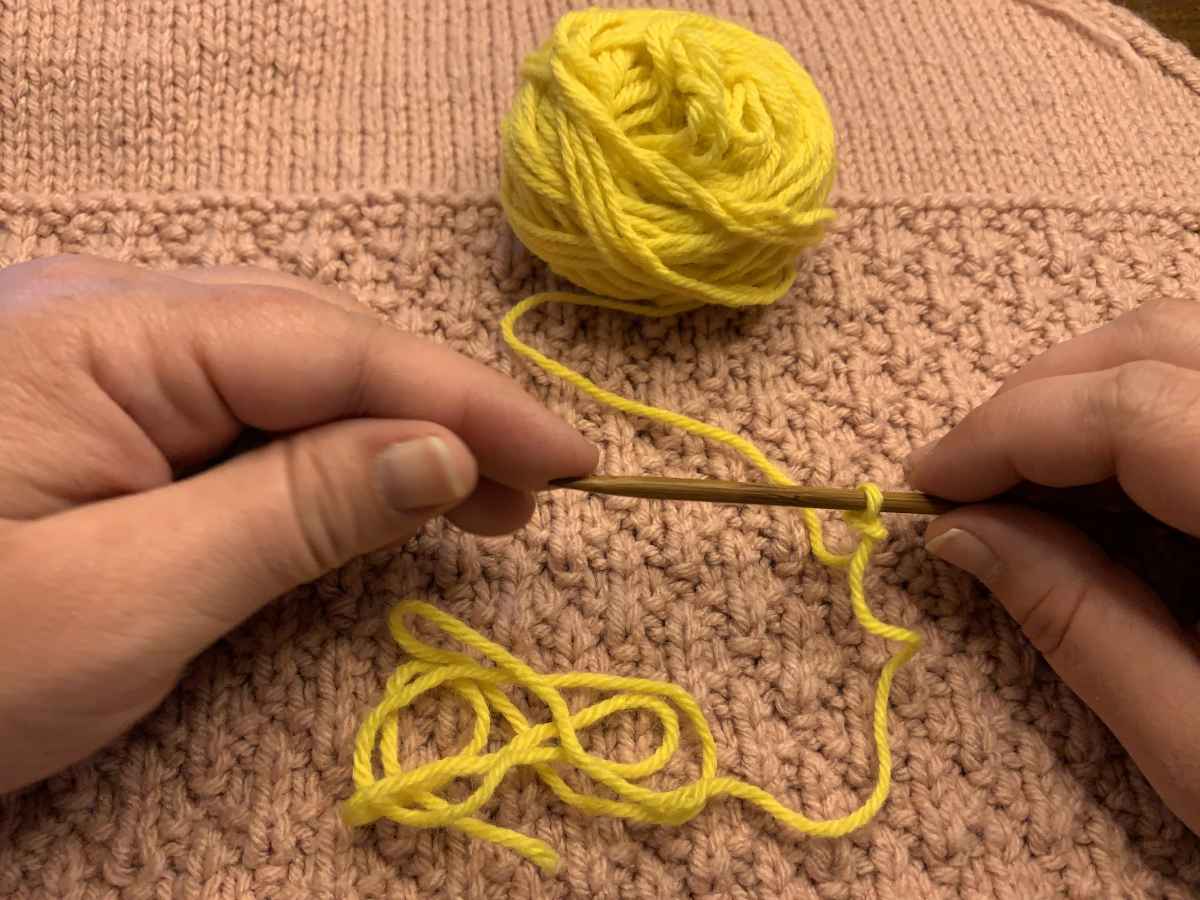

Step 2. Hold onto the yarn with the bottom of your palm and your ring and pinkie fingers.
 Step 3. Using your index finger and thumb separate the yarns with the long tail near you being held by the outside of your thumb and the yarn attached to the ball held on the outside of your index finger.
Step 3. Using your index finger and thumb separate the yarns with the long tail near you being held by the outside of your thumb and the yarn attached to the ball held on the outside of your index finger.

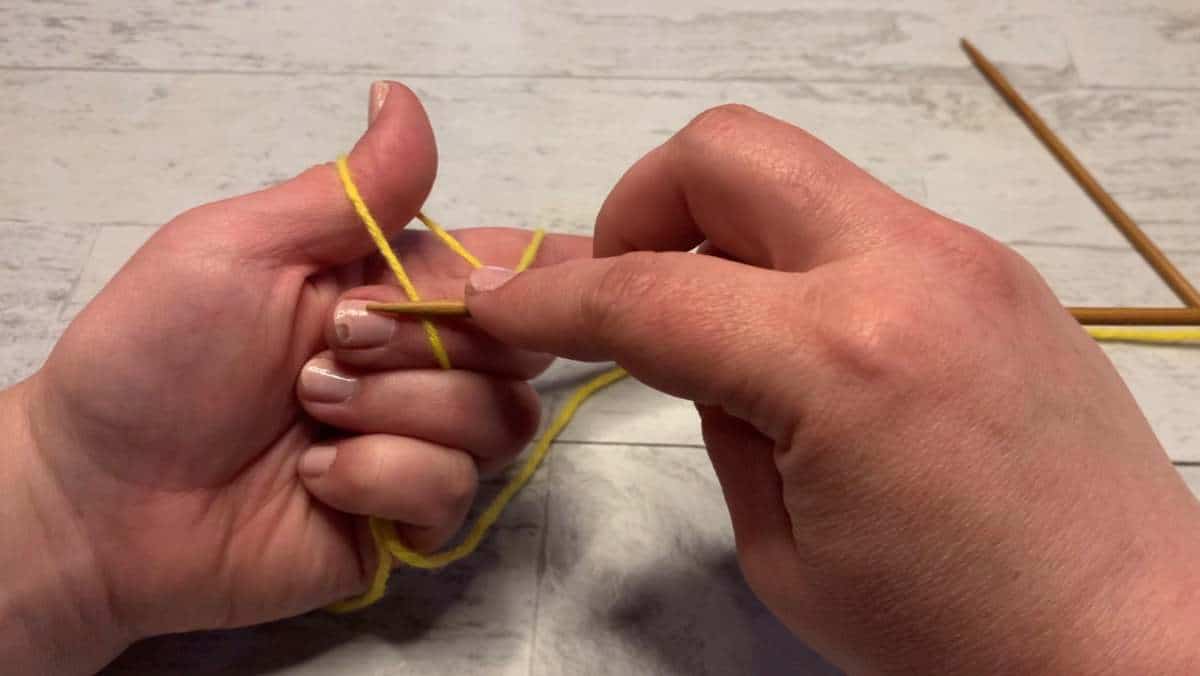
Step 4. Take your needle and move it to the yarn on the outside of your thumb, press down until it is holding the yarn.
Step 5. Swing your needle so that the yarn is now wrapped around the needle and bring your needle up and over the yarn on the outside of your index finger.


Step 6. Bring your needle down on the yarn on the outside of the index finger.
Step 7. Swing your needle back out towards your thumb and through the gap in yarn held by your thumb.

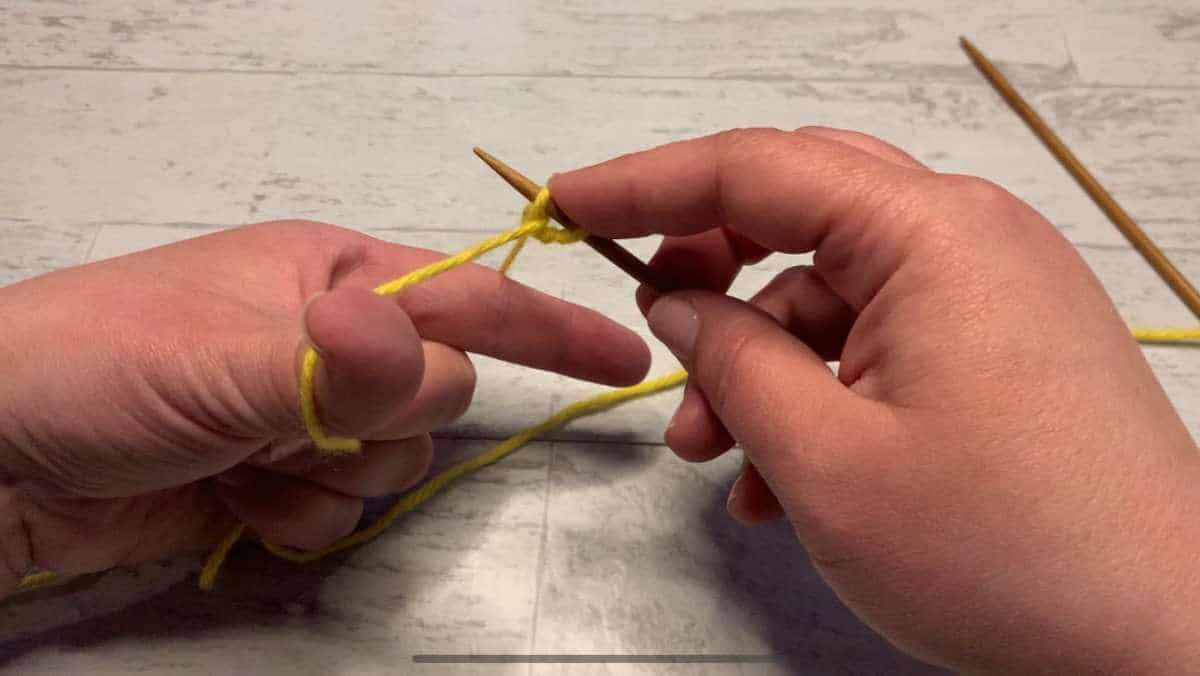
Step 8. Drop the yarn from off your thumb and bring your thumb to the outside to pick up the long tail again. Pull to the appropriate tightness for your knitting gauge.
Caution!
Do not pull too tight! Remember what your knitting gauge looks like – this is what this stitch should look like as well. It will not be matchy match yet, because the cast on edge is different, but aim for the space and feel and once you knit, your knitting will pull the cast on stitches into place.
Repeat steps 3 through 8 until you have cast on the desired number of stitches.
Graduation Day!
CONGRATULATIONS! You Did It!
Remember guys: C’s get degrees! If you still have practice to do, no worries!
How did you do? I can’t wait until you measure your long tail and end up with the perfect tail each time!
If you’re on IG and that happens because of this tutorial – tag me and tell your knitting friends!!! @ozzylosiknits! Or hashtag me #ozzylosiknitdesigns
I’m so excited for your cast on edge matching your knitting gauge! I can’t wait until you feel so confident in longtail casting on that all these tiny steps we covered today are a distant memory!
Still having trouble? Leave me a comment or send me an email! I’d love to hear from you and help in any way I can!
Did you love the detail in this tutorial?
Happy knitting!
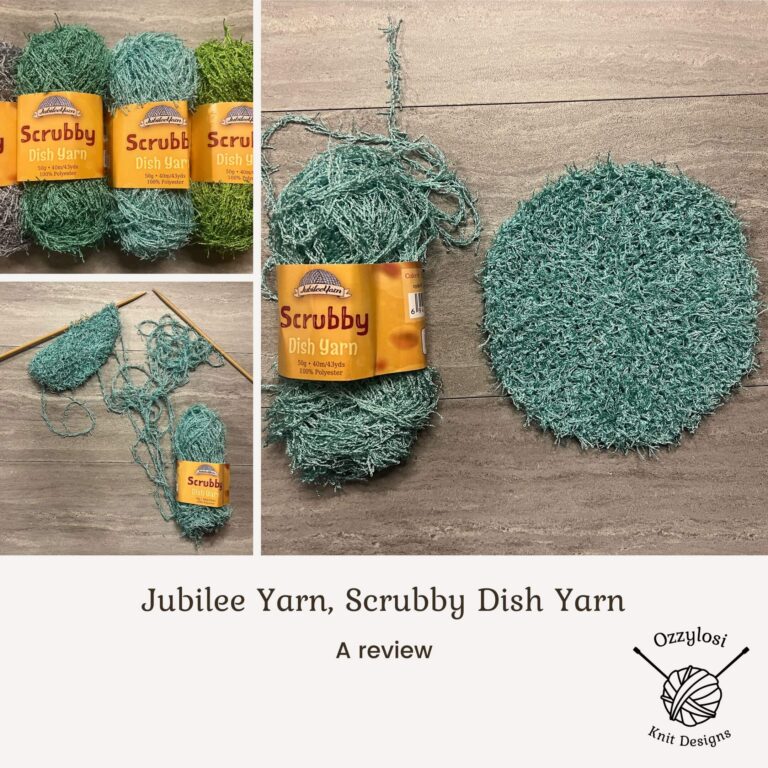
Jubilee Scrubby Dish Yarn Review
Wondering about Jubilee Yarn’s Scrubby Dish Yarn, check out my review and see if it’s right for you!

Knit Table Runner Free Pattern Lite: Blush and Bashful
The Blush and Bashful Knit Table Runner Free Pattern Lite is available for free. Includes written and charted instructions

Line Art Beanie Pattern Lite
Enjoy the FREE knit pattern lite for Line Art Beanie! Blog post includes all charted instructions. Full written instructions are included in the paid pattern.

Part 2 – How to knit without a pattern What can I knit with the yarn I have?
There are more things to consider when knitting without a pattern. We are going to take a look at some questions you may want to ask yourself as you begin planning to knit without a pattern.
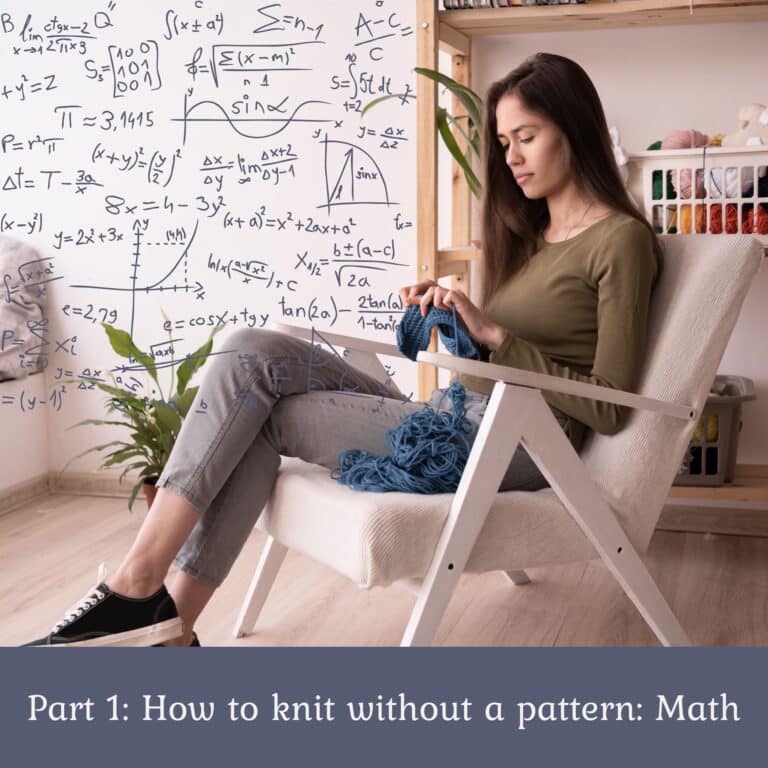
Part 1 of How to knit without a pattern: Math
Are you ready to knit without a pattern? Good news! You can learn to knit by knitting without a pattern. In this blog post we will take a look at the math needed to cast-on and knit without a pattern.

Free Knit Pattern Lite (like a knit pattern, but NOT a knit pattern)
Hello friend! In the section below are links to knit pattern lites that are like knit patterns, but are not knit patterns. So, what I mean by that, is these are items you can make from a simple pattern. BUT no one has tech edited or test knit these knit tutorials.







2 Comments